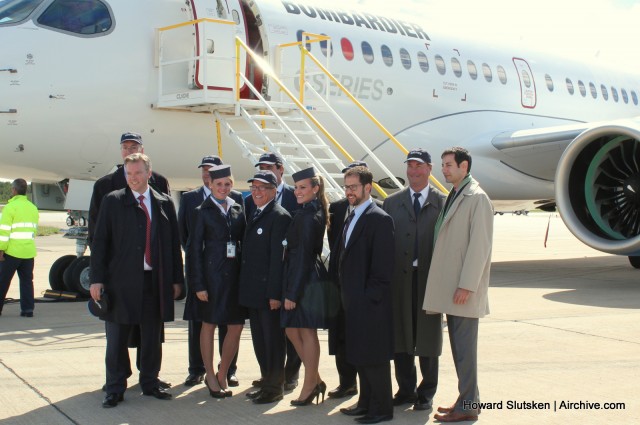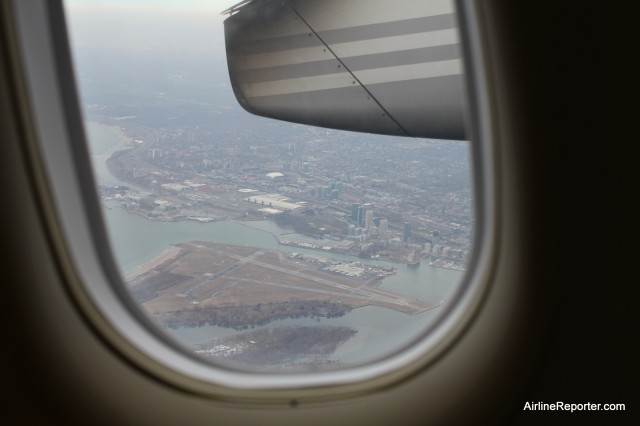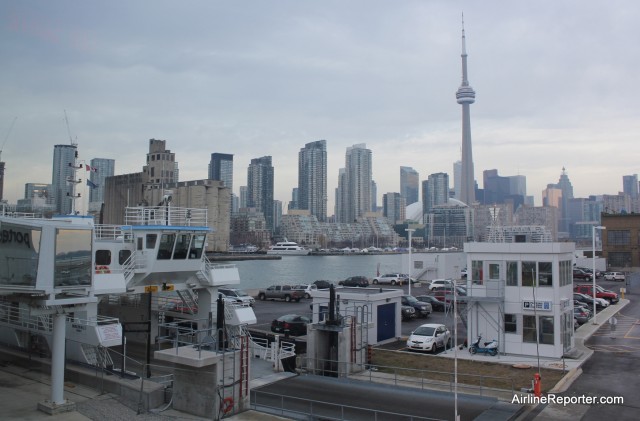
Mr. Robert Deluce, Porter Airlines President & CEO (center) with his team
after CSeries Flight Test Vehicle 1’s (FTV1) first flight on September 16, 2013.
It’s been over six months since Porter Airlines announced their conditional order to buy up to 30 Bombardier CS100s. In order to finalize the order, Porter needs permission from the City of Toronto to operate the CS100s at Billy Bishop Toronto City Airport (YTZ), and has asked for extensions to be added to both ends of the main runway at the waterfront airport. Currently, jets are not allowed to operate from YTZ, and Porter flies Bombardier Q400 turboprops from their YTZ base.
BONUS: Review- Flying Porter Airlines From Toronto to Montreal and Back
On Thursday morning, Toronto’s Deputy City Manager filed a report that analyzed Porter’s requests. Simply, it says that granting approval is premature. Among issues cited, there isn’t yet enough noise or operational performance data on the CS100; runway extension impact and noise modelling has not been completed; and there isn’t a clear direction or plan for YTZ’s expansion, and how it will be funded is in question.
In addition, the agreement banning jets at YTZ expires in 2033, and the report says that the impact of Porter’s request should be considered before this no-jet-noise agreement is extended. Overall, the report recommends that research continue, and that a new report be filed in March 2015. Thursday’s report will be considered by the City’s Executive Committee on December 5th, and depending on the outcome, by the full Council on December 16th.

Billy Bishop Toronto City Airport (YTZ) seen from the Porter Airlines Q400 – Photo: David Parker Brown
Part of this issue may be impacted by a Transport Canada airport safety initiative. Since the Air France Flight 358 overrun at YYZ in 2005, Transport Canada has been investigating additional requirements for runway safety. That work may result in regulations for Runway End Safety Areas (RESA), giving an additional margin for aircraft that undershoot or overshoot a runway.
Current regulations suggest that a RESA be at least 90m (300 ft) long at each end of a runway. In a recent speech, Toronto Port Authority Chairman Mark McQueen said the required RESA at YTZ might be 50 meters (165 ft). Porter has asked for either a 168 meter (550 ft) or a 200 meter (650 ft) extension to both ends of YTZ’s main Runway 08/26, which is now 1,219 meters (4,000 ft) long. Both extensions include a RESA.
I got my pilot’s license at YTZ in the late ’70s, when it was called the “Toronto Island Airport.” The main runway’s thresholds were, and still are, right at the water’s edge. That makes it challenging to extend the runway, but certainly not impossible. Over the years, large housing developments have been built just across the water from the airport, and that’s why the “no-jets” noise agreement was put into place in 1983.

On the ferry after arriving at Billy Bishop Airport – Photo: David Parker Brown
The clock can’t be turned back, so we can only hope that the airport and nearby residents will work together with the City of Toronto, Porter Airlines, and Transport Canada to end up with a solution that’s acceptable to all parties. I think it would be great to be able to fly to YTZ on a direct CS100 flight from my home airport of Vancouver (YVR).
Personally, having been on the ramp at Mirabel when FTV1 had its first flight, I think the folks near YTZ will be surprised at the quietness of the CS100. I thought that FTV1 had a different kind of sound than the Q400, a bit smoother to my ear than the low-frequency sound from the Q400’s six-bladed prop. But that’s my impression. I don’t have to live next door to an airport where CS100s will spool up for 7:00 am flights.
The Deputy City Manager’s report suggests that it’ll be 2015 before there will be enough data for Toronto City Council to make their decision. Bombardier is still saying that the CS100 will enter service one year after its first flight, which would put it into airline operation starting in September, 2014. If that’s the case, one would think there’d be plenty of data available sometime over the next six months. But so far, FTV1 has only had nine test flights over two months, and about 200 hours of combined air and ground testing of the planned 2,400 hour test schedule. FTVs 2-5 are yet to roll out and fly. Might Bombardier revise the CSeries flight test schedule and Entry-into-Service (EIS)?
What do you think? Will Toronto City Council press forward with Porter’s request? Will CS100s ever fly from YTZ?
Comments are closed here.